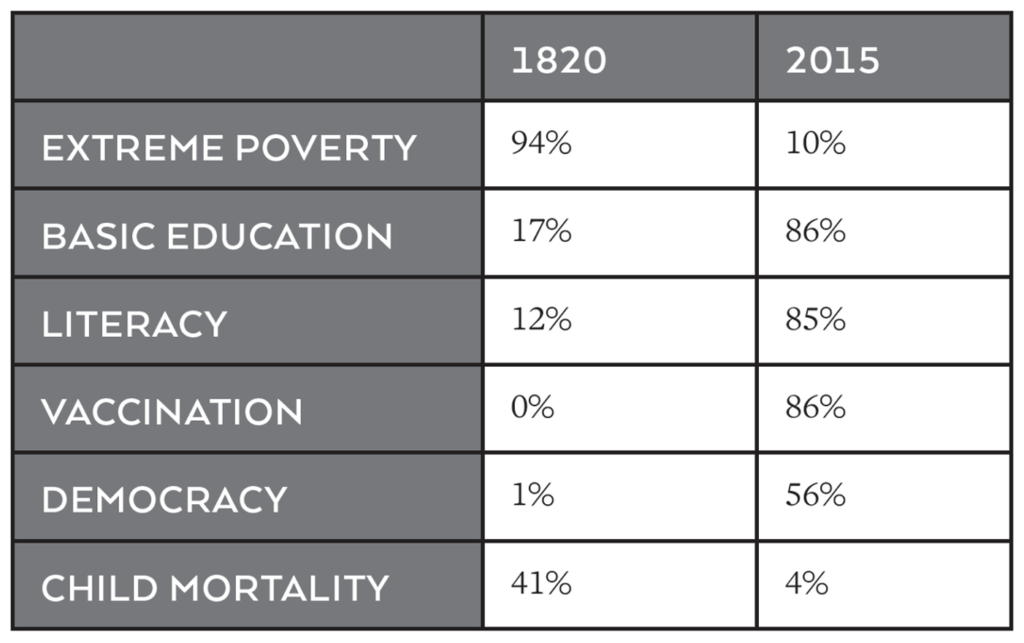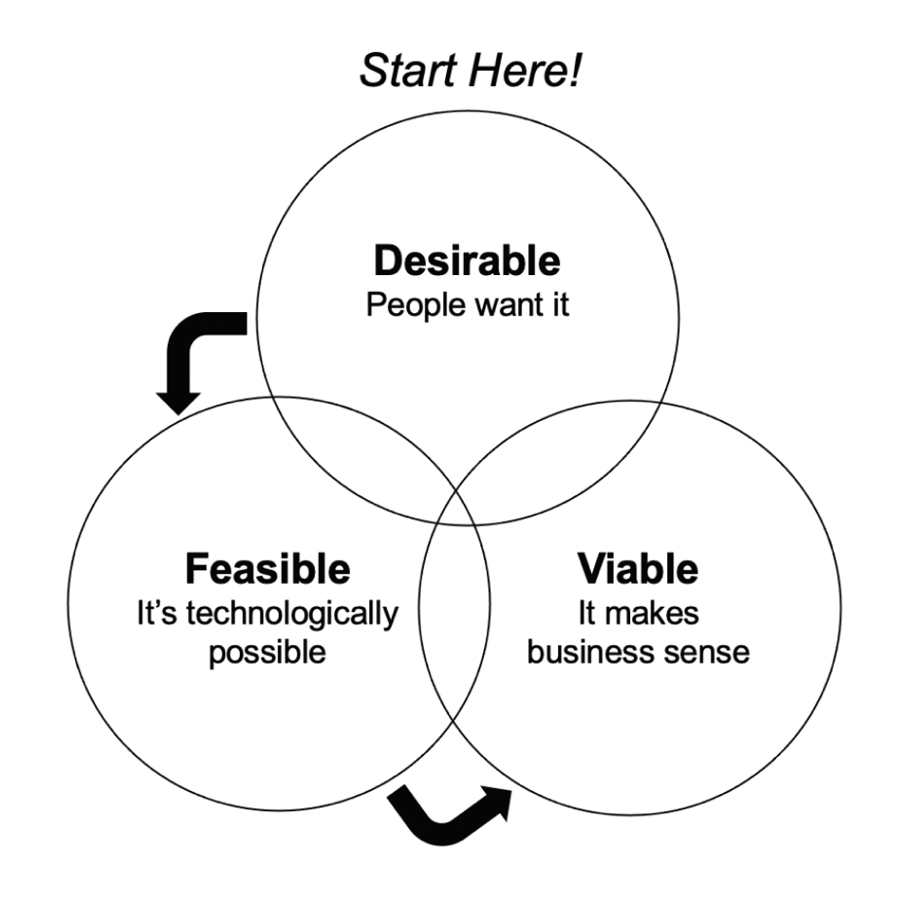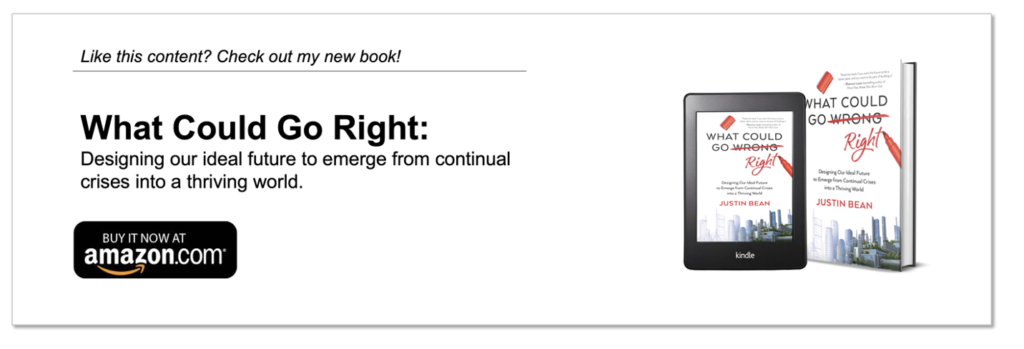What comes to mind when you hear the word “Utopia”? Innocence, naiveté, or even a false promise used to mislead people into dystopia?
Our wariness of the word is understandable, but we may have swung the pendulum too far in the other direction. The majority of our stories and narratives about the future are dystopian – The Terminator, Black Mirror, 1984 for example are entertaining and even cautionary tales about the dangers of the misuse of technology.
From what we see on social media, cable news, and movies about the future, we don’t have much to be grateful about or look forward to. They would have us believe everything is already terrible, getting worse by the day, and will only be worse in the future.
But how bad are things, really, and are we destined for the apocalyptic futures we see in these stories?
Of course it’s important to understand the challenges we face, and how bad things could get so we can avoid those outcomes. But if that’s all we can imagine about our future, and even if we fight this negative future, we won’t have a destination to walk towards.
So why is it so important to imagine what our future Utopia might be? Without a vision of the future we actually want, how can we work in the right direction to build it?
The good news is that we have a good record of progress, and humanity has come a very long way very quickly to get to where we are today – a place that our recent fore-bearers would’ve considered utopian.

Imagine walking into a saloon in the Old West, and telling the people about their future – the world we live in today. Most of the diseases they faced would be eradicated, a global communication network would connect humanity through language, images, business, etc., and nearly all people would have access to electricity, horseless carriages, and nearly unlimited information. In fact, our biggest struggles would be how to manage our abundance, in terms of sustainability, health, and attention. You would probably be thrown out on your keister.
Now imagine someone from 2150 (if we get the future “right” or even show any reasonable progress) walking into a cafe today and telling us what they consider to be everyday conveniences and expectations. Our reaction would probably be similar to our Old West friends – one of disbelief, suspicion, and ridicule.
Thanks to the work of our ancestors, we enjoy and incredible wealth, knowledge, and lives of relative safety and ease.
Our task is to take the next step, and create a world for our children that is sustainable, equitable, and abundant. The way to avoid dystopia and create a better future then is to out-imagine, out-innovate, and out-create the complacency, fatalism, and laziness of mind that could lead us to a dystopian world.
It’s actually much easier to imagine worst-case scenarios than better ones, because the worst case is based on what we already know, whereas imagining the best possible outcomes challenges us to create – in our minds – new ways of living and operating that we haven’t seen before.
One methodology used the world over by startups, product designers, inventors, and innovation team is called design thinking, developed at Stanford’s d.School.
Instead of starting be imagining what is possible, or what can be done within available budgets, design thinking asks us to first get to know the people we’re designing a solution for, the problem we’re trying to solve, and then imagine the most ideal solutions.
Experts who’ve studied how to build products and businesses with this framework all agree that outcomes are better when we start with understanding the people we are designing for and we envision the ideal and most desirable scenarios, then cut down our plans from there to only include what’s technically feasible and financially viable.

All successful projects, products, or services need to be desirable, feasible, and viable, and that order is deliberate—they always start with desirability.
Feasibility asks the question, “Can it technically be done?” If you start any effort with feasibility, you limit yourself to your known or existing technologies, methods, and systems.
Viability asks the question, “What will be financially sustainable?” If you start with viability, you’re first asking what customers are willing to pay for and how the project can be supported as a business. This limits your field of view and will cause you to miss potentially revolutionary solutions and business models if you haven’t figured out what people really want first.
When you start with desirability, you’re asking, “What do people really want?” Freed from the constraints of feasibility and viability, you can imagine the ideal future, product, or solution. This will also force you to rethink what the underlying want or need is, instead of a solution looking for a problem.
Taking this approach to our future, we can first envision the most ideal Utopia possible, and then filter visions and solutions by what is feasible and viable to create real solutions that put us on the path to a better (if imperfect) future.
The good news is that we actually live in the best time in human history for innovation, creativity, and the actualization of a future that would be considered Utopian by today’s standards. There are several megatrends enabling us to accomplish previously impossible feats to build this future, and thrive by doing so:
- Democratization of capital: In 2009, crowdfunding raised less than $2 billion globally. By 2016, it amounted to more than $34 billion, and it is projected to reach $300 billion in 2030. This capital is reaching more businesses, projects, and social causes, on the order of nearly 6.5 million in 2019. Equity crowdfunding also helps democratize the economy by helping more people invest in these ideas, early to share in their higher growth and returns of their success.
- Democratization of tools and teams: The rapid growth and availability of distributed collaboration platforms like Asana, Teams, and Airtable, along with the ability to hire remote workers affordably on platforms like Upwork and Fiverr, and low-code or no-code solutions makes it easier than ever for anyone to ideate, plan, collaborate, and build new solutions.
- Societal recognition of the need for sustainability and ethics: Millennials and Gen Z make up 42% of the US population, and are growing in economic and political influence – and are extremely adept at using digital communication and tools. They demand corporate sustainability, social responsibility, reward brands that further social and environmental causes, and will turn on brands in a heartbeat if they are found to have acted unsustainably, disingenuously, or unethically.
- Rapid growth of markets for sustainable solutions: Recent studies by Boston Consulting Group and the World Economic Forum found that companies who incorporated environmental or social impact into their businesses enjoyed 4-25% higher revenues, lower costs of financing (-100 bp WACC), lower regulatory risks, 12.4% higher margins on average, and 3%-19% higher valuation multiples. They also operate in green alternative markets which are growing from 6-28X faster than conventional ones.
The companies that embrace these trends and use their resources to envision and build the future will be the most successful. Support their efforts with your wallet. The public servants who move on from divisiveness, and instead inspire people with credible visions of the future, and plans or policy ideas to get us there will enable us to reach a better future faster. Please consider this in the voting booth. The entrepreneurs who envision an ideal future, and build solutions that will accelerate our progress towards it will become incredibly successful. Please consider your career path and work choices with this in mind.
While we may never reach a complete Utopia, if we envision a future that sounds Utopian to us, and build together in that direction, we just might help our descendants enjoy it as a commonplace reality – and envision a Utopia of their own to leave to their children – one that is beyond our wildest dreams.
Justin Bean is a tech executive, who is dedicated to building an environmentally and socially sustainable world. He has helped Fortune 500s, governments, and startups across the globe advance impact and innovation. He has an MBA from Presidio Graduate School and executive education from Stanford University and INSEAD. This article is based on excerpts from his book What Could Go Right, Designing our ideal future to emerge from continual crises to a thriving world. Available for purchase everywhere books are sold.
